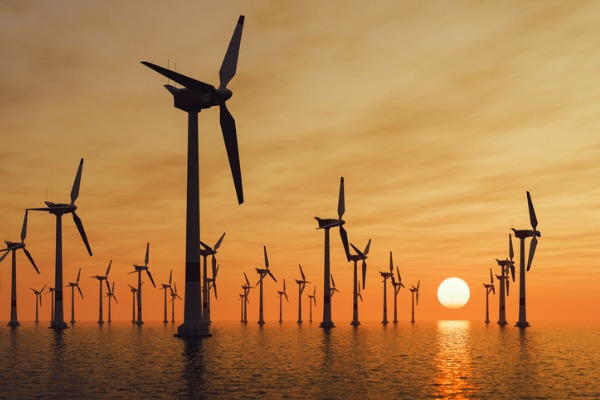When will these high-income investment trusts recover?
Will falling interest rates spark a recovery in infrastructure and renewables, asks Jennifer Hill.
7th October 2024 09:01
by Jennifer Hill from interactive investor

For income-seeking investors, the attraction of allocating to traditional infrastructure or renewable energy was clear: long-term, stable revenues that are often government-backed and inflation-linked.
However, as interest rates rocketed and demand for alternative sources of income plummeted, these investment trust sectors seriously sold off, causing share prices to plunge and move to deep discounts to underlying net asset values (NAVs).
- Invest with ii: Buy Investment Trusts | Top UK Shares | Open a Trading Account
Both sectors have high yields, with the average renewable energy infrastructure trust yielding 7.9%, and the average infrastructure trust yielding 5.9%.
With the Bank of England’s first rate cut in four years in August and further cuts expected (albeit slowly), is a recovery in the offing?
Below, we take a deep dive into why these sectors have been in the doldrums and ask what the future might hold.
What’s been the problem?
As FundCalibre managing director Darius McDermott points out, investors in infrastructure and renewables trusts “have witnessed a perfect storm in recent years”.
Chief among the problems was rapidly rising interest rates throughout 2022 and the first half of 2023. As higher rates made the returns from infrastructure and renewable trusts less competitive relative to lower-risk cash and bonds, investors reallocated their capital.
James Carthew, head of investment companies at QuotedData, further adds: “Investors had perceived these [infrastructure and renewables] funds, which had long traded close to asset value or at premiums, as very safe investments. As the selling pressure mounted, quite wide discounts emerged.”
Rising interest rates also affected the discount rates used to value assets. “Increasing the rate used to calculate discounted cash flow models translates into lower present values for companies’ future cash flows and lower valuations,” says McDermott.
At the same time, it made borrowings more expensive. As funds were forced to re-finance at higher rates, investment managers found it harder to take advantage of acquisition opportunities to grow their funds and shareholder returns.
David Liddell, a director at IpsoFacto Investor, notes: “Part of the problem was the speed at which rates rose from 2022, pushing trusts to discounts quickly and making short-term debt much more expensive.
“The business model, where trusts invested in limited life concession assets, required new investments to be made to refresh the portfolio. Once trusts sank to a discount, it became much more difficult to raise new equity money to finance investment in new assets. Investors seeing this were inclined to be even more negative towards the sector.”
How have the underlying investments performed?
The direction of energy prices has fed into the fortunes of renewable energy trusts.
“Looking back to 2021, both sectors thrived among an outlook that was very pro-infrastructure and renewable energy,” says James Igoe head of the Manchester office of Redmayne Bentley.
He adds: “Those strategies within the environmental, social and governance (ESG) and ESG-adjacent spaces performed strongly during that period, which came to a halt as energy markets went into flux following the Russian invasion of Ukraine in early 2022.”
Since the energy crisis, slightly lower electricity production and lower-than-expected electricity prices following two mild winters in Europe have compounded problems.
- Watch our video interview: where to find income now interest rates are falling
- Why stock markets are caught in a tug of war
William Heathcoat Amory, Kepler Partners managing partner, points out: “Additionally, inflation has fallen faster than many expected, including most of the renewable energy sector’s managers. As a result, NAVs have been falling,” he says.
Finally, there have been some company-specific issues. Take, for example, HICL Infrastructure PLC Ord (LSE:HICL), the largest core infrastructure trust. It has been affected by the impact of Covid-19 on transport assets, such as High Speed 1 (formerly known as the Channel Tunnel Rail Link), which stopped paying distributions. Affinity, its largest investment, also suffered as investors worried about regulation of water companies.
For Digital 9 Infrastructure Ord (LSE:DGI9), the “pain has been self-inflicted”, says Ben Yearsley, co-founder of Fairview Investing. Its shares have dropped to a -60% discount amid governance concerns and funding issues. Shareholders approved a proposal to wind down the trust in March, just three years after it launched.
“Many of the later trusts that launched have proved the worst with poor funding models and average business plans,” says Yearsley. “Many of these later trusts probably won’t recover and should be avoided.”
Is the outlook any brighter for the others?
“Good has been tarred with the same brush as bad”, according to Yearsley, who sees brighter times ahead for other trusts in the sector. “With interest rates falling now, even small cuts help the outlook for the sector,” he says.
Lower interest rates would help in several ways. “The most direct is that if long bond yields also fell, this would likely reduce the discount rate used to value the assets, and thus boost NAVs,” says Heathcoat Amory.
In addition, a wider spread between the income generated by these trusts and 10-year gilt yields (currently more than 3%) would increase the relative attraction to income investors. Trusts being able to refinance at lower rates would reap another benefit.
- Sign up to our free newsletter for investment ideas, latest news and award-winning analysis
- Top 10 most-popular investment trusts: September 2024
Heathcoat Amory points to another potential macro move that would benefit the renewables sector: a significant recovery in wholesale electricity prices.
“The gas price is what effectively sets the wholesale electricity price, and Europe as a whole has done a good job at moving away from Russian gas supply,” he says. “However, since the start of the Ukraine conflict, it has not yet been unequivocally tested.”
He adds: “Electricity prices appear to have halted their decline, and if expectations for higher prices hold – or a long cold spell this winter leads to significantly higher prices – this could be a catalyst for power expectations to be reset higher.
“Higher power prices feed directly into higher cash flows for those trusts that are unhedged and would mean higher revenues with which to pay dividends, buy back shares or reinvest in generating assets.”

Should I invest now and how much?
For Redmayne Bentley’s Igoe the story for renewable energy remains intact.
He says: “To meet 2030 and 2040 quotas for carbon emission reductions, there needs to be an enormous allocation to renewable energy projects, which we have yet to see take full effect.
“Add to this more demand for processing power from semi-conductor-related take up, such as growth in data centres highlighted in NVIDIA Corp (NASDAQ:NVDA)’s results, which requires energy to support the new infrastructure and needs to be provided by renewable and not traditional energy forms.”
At the same time, IpsoFacto’s Liddell points to investment in UK infrastructure being “arguably needed more than ever but the government remains cash strapped”.
Cash flows from underlying investments have generally held up well, while also offering some direct inflation protection not often available elsewhere, he adds.
He suggests a lower-risk portfolio with up to 40% in cash, bonds and alternative investments could have up to 10% in alternative income.
FundCalibre continues to be attracted to both sectors due to the natural diversification and energy transition opportunities and suggests exposure at around 15%.
Which trusts do analysts recommend?
IpsoFacto likes trusts that are large (scale makes disposals easier, giving more flexibility), well diversified and able to raise their dividends. “In infrastructure, HICL meets these priorities,” says Liddell.
QuotedData likes Pantheon Infrastructure Ord (LSE:PINT), which at the start of October traded on one of the widest discounts of its peers at -23.2%.
“Part of the problem may be that, like the well-regarded and relatively highly rated 3i Infrastructure Ord (LSE:3IN), the Pantheon trust aims for a mix of capital growth and income,” says Carthew. “The compromise for both trusts is a lower dividend yield, but it seems reasonable that as investors get more familiar with Pantheon Infrastructure, it will be re-rated.”
- Baillie Gifford investment trust to merge with sister fun
- How are trusts navigating a stock market colossus?
Fairview Investing like trusts with covered dividends such as International Public Partnerships Ord (LSE:INPP) in the core infrastructure sector and Downing Renewables & Infrastructure Ord (LSE:DORE) in the renewables sector.
Peel Hunt favours Octopus Renewables Infrastructure Ord (LSE:ORIT) and Greencoat UK Wind (LSE:UKW).
“We continue to see appeal in Greencoat UK Wind’s explicitly inflation-linked dividend policy, strength of cash flow generation providing firepower for dividend growth, share buybacks and funding flexibility,” says analyst Markuz Jaffe.
Greencoat UK Wind has one of the narrowest discounts in the peer group at -11.5%, while Octopus Renewables Infrastructure Trust has one of the highest at -25.3%. Jaffe highlights the latter trust’s robust performance and “successful execution of its capital recycling programme”.
For those with the risk tolerance to pick single company shares, Igoe highlights SSE (LSE:SSE) “given its exposure to wind power and the potential growth in this space with Great British Energy acting as a tailwind”.
These articles are provided for information purposes only. Occasionally, an opinion about whether to buy or sell a specific investment may be provided by third parties. The content is not intended to be a personal recommendation to buy or sell any financial instrument or product, or to adopt any investment strategy as it is not provided based on an assessment of your investing knowledge and experience, your financial situation or your investment objectives. The value of your investments, and the income derived from them, may go down as well as up. You may not get back all the money that you invest. The investments referred to in this article may not be suitable for all investors, and if in doubt, an investor should seek advice from a qualified investment adviser.
Full performance can be found on the company or index summary page on the interactive investor website. Simply click on the company's or index name highlighted in the article.